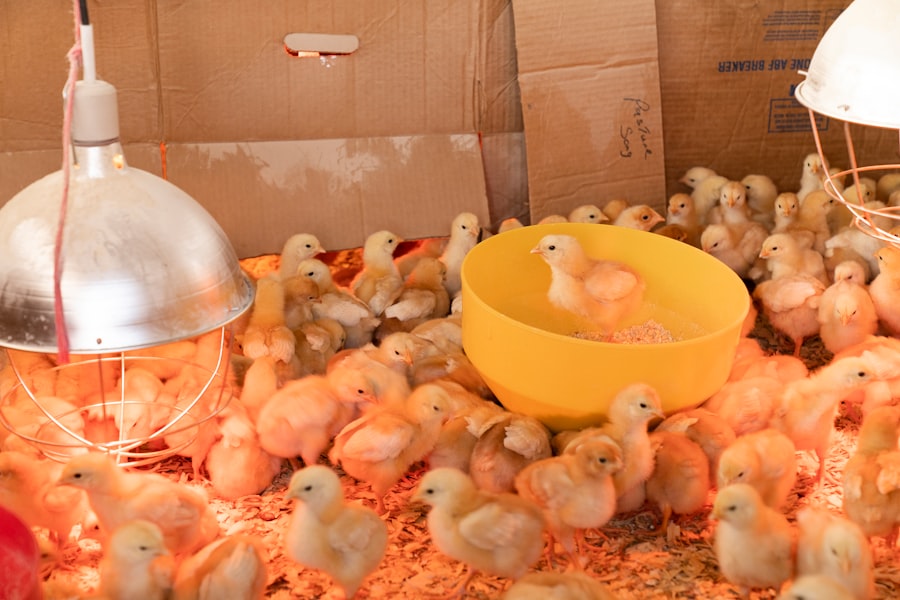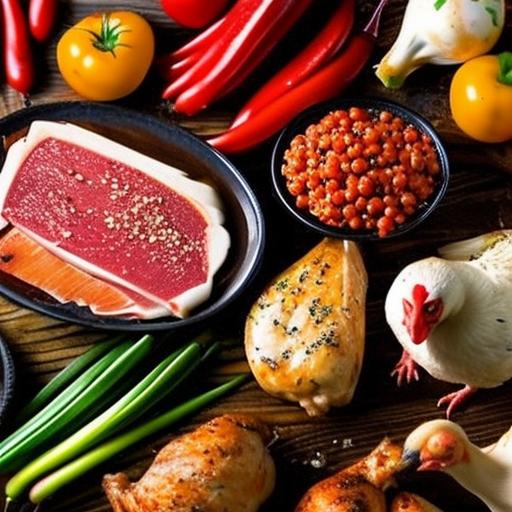Raising meat chickens is a popular practice among homesteaders and small-scale farmers. Unlike egg-laying chickens, meat chickens are specifically bred for their meat production and grow at a much faster rate. This makes them an ideal choice for those looking to raise their own meat. However, in order to raise healthy and productive meat chickens, it is important to provide them with a suitable living environment. This is where the chicken coop comes in.
A chicken coop is a structure that provides shelter and protection for the chickens. It serves as their home, where they can roost, lay eggs (if they are dual-purpose breeds), and seek refuge from predators and harsh weather conditions. A good chicken coop is essential for the well-being of the chickens and the success of the meat production venture.
Key Takeaways
- Cornish Cross is the most popular meat chicken due to its fast growth and high meat yield.
- Freedom Rangers are a slow-growing alternative that produces flavorful meat and is better suited for free-range environments.
- Red Broilers are a colorful choice for meat and are known for their hardiness and adaptability.
- Dual-purpose breeds like the Plymouth Rock and Sussex can provide both meat and eggs, making them a practical choice for small-scale farming.
- When choosing a chicken coop for meat birds, consider size, ventilation, and ease of cleaning to ensure a healthy and productive flock.
Cornish Cross – The Most Popular Meat Chicken
When it comes to meat chickens, the Cornish Cross breed is by far the most popular choice in the industry. These chickens are a cross between a Cornish chicken and a White Plymouth Rock chicken, resulting in a bird that grows at an incredibly fast rate. In fact, Cornish Cross chickens can reach market weight in as little as 6-8 weeks.
The rapid growth rate of Cornish Cross chickens is both a pro and a con. On the positive side, it means that you can raise a large number of birds in a relatively short amount of time. This makes them an efficient choice for those looking to produce meat on a larger scale. However, the fast growth rate can also lead to health issues such as leg problems and heart failure if not managed properly. It is important to provide these birds with plenty of space, proper nutrition, and regular exercise to ensure their well-being.
Freedom Rangers – A Slow-Growing Alternative
For those looking for a slower-growing alternative to Cornish Cross chickens, Freedom Rangers are a great option. These chickens are known for their excellent meat quality and flavor, and they have a more natural growth rate compared to Cornish Cross chickens. While they take longer to reach market weight (around 11-12 weeks), many people prefer the taste and texture of the meat from Freedom Rangers.
One of the benefits of raising Freedom Rangers is that they are more active and forage more than Cornish Cross chickens. This means that they can be raised on pasture, which not only provides them with a more natural diet but also reduces the need for expensive feed. Additionally, Freedom Rangers are known to have better leg health and overall vitality compared to Cornish Cross chickens.
Red Broilers – A Colorful Choice for Meat
If you’re looking for a meat chicken with a unique appearance, Red Broilers are a great option. These chickens have a beautiful reddish-brown color and are known for their flavorful meat. They have a slightly slower growth rate compared to Cornish Cross chickens, reaching market weight in around 9-10 weeks.
Raising Red Broilers can be a rewarding experience, as their vibrant color adds visual interest to your flock. They also have good foraging abilities and can be raised on pasture, similar to Freedom Rangers. However, it is important to note that Red Broilers may not grow as quickly or have as high of a meat yield as Cornish Cross chickens. This is something to consider if you are looking for maximum meat production.
Dual-Purpose Breeds – Meat and Eggs in One
If you’re interested in raising chickens for both meat and eggs, there are several dual-purpose breeds to choose from. These breeds are specifically bred to excel in both meat production and egg-laying, making them a versatile choice for small-scale farmers and homesteaders.
Some popular dual-purpose breeds include Rhode Island Reds, Plymouth Rocks, and Sussex chickens. These breeds are known for their hardiness, good egg production, and decent meat quality. While they may not grow as quickly as Cornish Cross or Freedom Ranger chickens, they offer the advantage of being able to provide both meat and eggs from the same flock.
Choosing the Right Chicken Coop for Meat Birds

When it comes to selecting a chicken coop for meat birds, there are several factors to consider. First and foremost, you’ll need to determine the size of the coop based on the number of chickens you plan to raise. It is recommended to provide at least 2 square feet of space per bird inside the coop, and even more if they will be confined for extended periods.
In addition to size, it is important to choose a coop that provides adequate ventilation and protection from predators. Good ventilation is essential for maintaining a healthy environment inside the coop and preventing respiratory issues. The coop should also have secure doors and windows to keep out predators such as raccoons, foxes, and snakes.
Other features to consider when selecting a chicken coop for meat birds include roosting bars, nesting boxes (if you are raising dual-purpose breeds), and easy access for cleaning. It is also a good idea to choose a coop that is easy to move or has wheels, especially if you plan on raising your meat chickens on pasture.
Raising Meat Chickens on Pasture
Raising meat chickens on pasture has become increasingly popular in recent years, as it offers several benefits for both the chickens and the environment. Pasture-raised meat chickens have access to fresh air, sunlight, and a diverse range of plants and insects to forage on. This results in healthier and more flavorful meat.
One of the main benefits of raising meat chickens on pasture is that it reduces the need for expensive feed. Chickens raised on pasture can supplement their diet with grass, bugs, and other natural food sources, which can significantly reduce feed costs. Additionally, pasture-raised chickens have a lower impact on the environment compared to chickens raised in confinement, as they help to improve soil health and reduce the need for chemical fertilizers.
Managing a pasture-raised meat chicken flock requires careful planning and rotational grazing. It is important to provide the chickens with enough space to roam and forage, while also protecting them from predators. Regularly moving the chicken coop to fresh pasture ensures that the chickens have access to new food sources and helps to prevent overgrazing.
Feeding Meat Chickens for Optimal Growth
Feeding meat chickens a balanced diet is crucial for their growth and overall health. While they may have different nutritional requirements depending on their breed and age, there are some general guidelines to follow.
For starter chicks, it is recommended to provide a high-quality chick starter feed that is specifically formulated for meat birds. This feed should have a protein content of around 20-22% to support rapid growth. As the chickens grow, you can gradually transition them to a grower feed with a slightly lower protein content.
In addition to commercial feed, it is important to provide meat chickens with access to fresh water at all times. Water is essential for digestion, nutrient absorption, and overall hydration. It is also a good idea to offer supplemental treats such as fruits, vegetables, and insects to provide additional nutrients and keep the chickens entertained.
Processing and Butchering Meat Chickens
Once your meat chickens have reached market weight, it’s time to process and butcher them. Processing refers to the initial steps of preparing the chickens for butchering, such as slaughtering and removing feathers. Butchering involves cutting up the chicken into individual cuts of meat.
When it comes to processing and butchering meat chickens, it is important to prioritize humane practices. This means ensuring that the chickens are handled with care and that their slaughter is quick and painless. There are several methods of slaughtering chickens, including using a sharp knife, a killing cone, or a mechanical killing device. It is important to choose a method that you are comfortable with and that is legal in your area.
After slaughtering, the chickens should be scalded in hot water to loosen the feathers and then plucked. Once the feathers have been removed, the chickens can be eviscerated (removing the internal organs) and cleaned. It is important to work quickly and efficiently to ensure that the meat stays fresh and safe to consume.
Best Practices for Keeping Meat Chickens and Chicken Coops
Raising meat chickens can be a rewarding and sustainable practice for homesteaders and small-scale farmers. By selecting the right breed, providing a suitable living environment, and following best practices for feeding and management, you can raise healthy and productive meat chickens.
When it comes to selecting a chicken coop for meat birds, it is important to consider factors such as size, ventilation, predator protection, and ease of cleaning. Providing adequate space and access to pasture can also have a positive impact on the health and well-being of the chickens.
Feeding meat chickens a balanced diet that meets their nutritional requirements is crucial for optimal growth. This includes providing them with high-quality commercial feed as well as supplemental treats.
Finally, processing and butchering meat chickens should be done with care and in a humane manner. Following proper procedures ensures that the meat is safe to consume and that the chickens are treated with respect.
By following these best practices, you can successfully raise meat chickens and maintain a healthy chicken coop. Whether you choose Cornish Cross, Freedom Rangers, Red Broilers, or dual-purpose breeds, raising your own meat can be a fulfilling and sustainable endeavor.
If you’re looking for the best chickens to keep for meat, you’ll definitely want to check out this informative article on Poultry Wizard. They have a comprehensive guide that highlights the top breeds for meat production, including their characteristics and growth rates. Whether you’re a beginner or an experienced chicken keeper, this article will provide you with valuable insights to help you make the right choice. To learn more, click here: https://poultrywizard.com/keeping-chickens/producers-pride-sentinel-chicken-coop/.
FAQs
What are the best chickens to keep for meat?
The best chickens to keep for meat are broiler chickens, Cornish Cross, and Freedom Rangers.
What is a broiler chicken?
A broiler chicken is a type of chicken that is specifically bred for meat production. They grow quickly and have a high feed conversion rate.
What is a Cornish Cross?
A Cornish Cross is a hybrid breed of chicken that is a cross between a Cornish chicken and a White Plymouth Rock chicken. They are known for their fast growth and large size.
What is a Freedom Ranger?
A Freedom Ranger is a breed of chicken that is known for its flavorful meat and ability to forage for food. They are a slower-growing breed compared to broiler chickens and Cornish Cross.
What is the difference between broiler chickens and Cornish Cross?
Broiler chickens and Cornish Cross are both breeds of chicken that are specifically bred for meat production. However, Cornish Cross chickens are known for their larger size and faster growth rate compared to broiler chickens.
What is the lifespan of a meat chicken?
The lifespan of a meat chicken is typically around 6-8 weeks, as they are bred for fast growth and early maturity.
What is the best way to raise meat chickens?
The best way to raise meat chickens is to provide them with a balanced diet, clean water, and a comfortable living environment. It is also important to provide them with enough space to move around and exercise.
Meet Walter, the feathered-friend fanatic of Florida! Nestled in the sunshine state, Walter struts through life with his feathered companions, clucking his way to happiness. With a coop that’s fancier than a five-star hotel, he’s the Don Juan of the chicken world. When he’s not teaching his hens to do the cha-cha, you’ll find him in a heated debate with his prized rooster, Sir Clucks-a-Lot. Walter’s poultry passion is no yolk; he’s the sunny-side-up guy you never knew you needed in your flock of friends!







